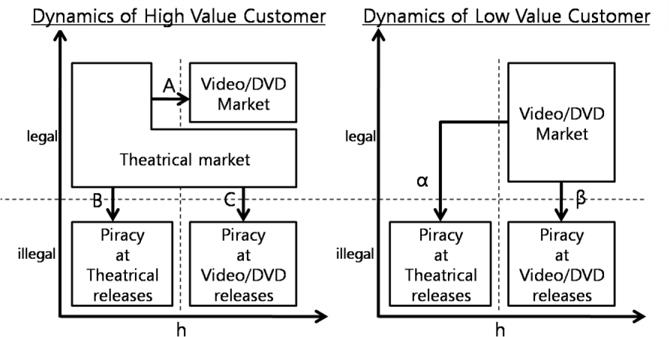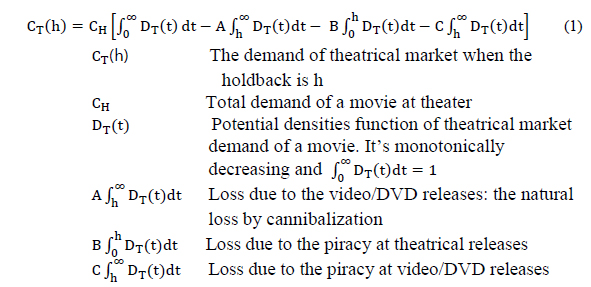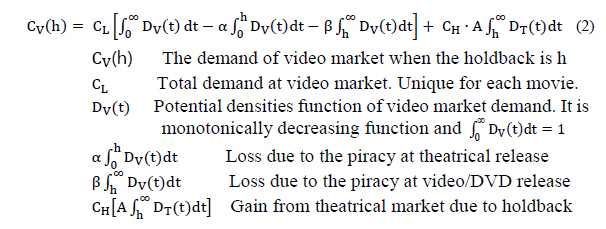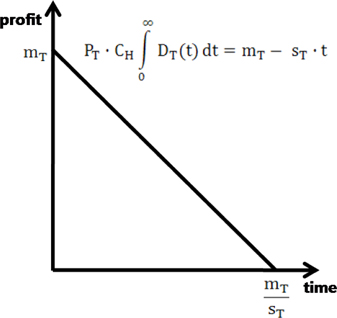



The movie industry engaged in a war on piracy starting in the 1970s. The major studios controlled the largest share of the film market. Through their powerful trade association, the Motion Picture Association of America (MPAA) these studios could actively counteract piracy. The MPAA and the major movie studios supported the enactment of anti-piracy laws, which prohibited piracy and laid out the prosecution procedure against of pirates. They also participated in the negotiation and licensing of technologies that could affect piracy. The strong distribution power of MPAA members allowed them to regulate new technologies like DVD to imbed digital rights management (DRM) both in hardware and software (Waterman et al., 2007). The MPAA seemed to hold a winning position in the war on piracy, but digital innovation changed the whole landscape. The widespread high-speed internet could deliver the movie content without quality degradation. Most digital devices (e.g. computer, phone, tablet) can access movie content that it is almost impossible to regulate through movie distribution power. The MPAA and movie studios introduced various DRM technologies in DVD to prevent piracy, but hackers regarded the breakup of new DRM technology as an attractive exercise in which they compete against each other for fame. Million-dollar DRM technology became useless as soon as introduced. Therefore, DRM technology development or technology regulatory actions are no longer effective in countering piracy.
In this regard, we believe that is a good time to revisit the price discrimination policy, which divides high-value customers and low-value customers. Every film customer has unique tastes. If a product meets his or her taste, that customer is willing to accept a high price. Thus, firms have creatively developed price differentiation methods to separate high-value customers from low-value customers to maximize profits. In the media and entertainment industry, time lag is preferred as a price differentiation method because customer preference is radically changed by the quality and attributes of intangible content. In the publishing industry, paperback versions of books are released after about a year of their hardcover release. In fashion industry, famous designers’ products are first introduced through their own sections in department stores then moved to lower price outlets after the fashion season has passed (Prasad et al., 2004).
The movie industry uses the most sophisticated method in the media and entertainment industry. Major studios usually release a movie over time, first to theaters, then to home video, pay-per-view, cable TV and broadcast networks. To protect each channel’s profits, they keep enough time lag between each release channel. This time lag is called a ‘holdback’ (Owen and Wildman, 1992).
Each channel in the movie industry has different experience and pricing, and the motivation and effect of piracy is also different in each channel. Therefore, controlling holdback can change the consumers’ motivation to engage in piracy along with education and law enforcement. The idea of holdback as a piracy counteract method was first mentioned in 2007 (Nelson et al., 2007; Waterman et al., 2007), but it was not tested theoretically until now.
Thus, this study examines holdback as a counteract method against movie piracy using the economic models of firm’s decision. Using duality of profit maximization and opportunity cost minimization, this study investigates how holdback can affect piracy, and suggests effective holdback strategy to address piracy. To achieve this objective, this study is organized in three parts. The first part reviews related studies on holdback and piracy. The second part investigates how movie distributors decide on holdback while considering the effects of piracy, using duality models in economics. The third part summarizes the findings and suggests further research areas.
The starting point of digital piracy is vague, but scholars believe that the technological advances of internet file sharing spontaneously induced the file sharing cultures. The development of network speed and the introduction of the World Wide Web accelerated the diffusion of digital piracy. In 2006, the indirect measurement of digital piracy showed that approximately half of the internet bandwidth in the United States was used for digital piracy activities (Williams et al., 2010). The piracy status report of the Chinese market revealed that about 90% of movies distributed in China were illegal copies (Proserpio et al., 2005; Stephens and Swartz, 2013).
There is no disagreement among movie industry experts that piracy, especially digital piracy, severely damages the market. There are various reports that estimate the damage of digital piracy in both the music and movie industries. In the academic field, however, there are different views. Some scholars even insist that piracy actually helps firms’ profitability (Hui and Ping, 2003; Peitz and Waelbroeck, 2004). They suggest that the damage of piracy on the music industry is under 10% percent, but network effect due to piracy helps firm’s profitability (Peitz and Waelbroeck, 2004).
With actual data being collected, it became accepted even among academics that digital piracy actually damages the industry. A study on the effect of piracy on the music industry using huge panel data of P2P site activities empirically proved that piracy of an album reduces its actual sales (Oberholzer and Strumpf, 2007). De Vany and Walls investigated the relationship between piracy and movie sales using time series data of piracy action and found that piracy reduces the theatrical market performance. In supply area, they found that diminishing numbers of customers led to theaters closing early in view of falling income. In demand area, diminishing numbers of customers falsely pointed to the offer of uninteresting movie and, thus, accelerated the loss of customers (De Vany and Walls, 2007).
To understand the digital piracy activity, scholars focused on the actual user behaviors in the face of piracy in various perspectives, and found key antecedent factors. Demographic factors like ages, gender, and education level seemed important at first, but recent studies reveal that perceived value, perceived harm, ethics, and social habit are crucial in decision-making of piracy activity (Park and Kim, 2011).
The movie industry developed anti-piracy strategies based on the long experience against various form of piracy and downloader’s behaviors. Before digital piracy, the movie industry experienced hard goods commercial piracy, consumer theft of TV signals and consumer copying and sharing of videos in analog format (Waterman et al., 2007). During this period, the industry developed effective laws and initiated lawsuits to discourage piracy activities. Using superior market power, the movie industry compelled media channels to utilize anti-copy technologies, and strengthen the security of pre-theatrical release leaks. These strategies seemed to be effective in the analog age. MPAA’s reports of loss prior to the digital age showed a decline in piracy activity over time (Waterman et al., 2007).
To counteract digital piracy, the movie industry pursued the same strategies used during the analog age, but obtained different results (Jeong and Khouja, 2013). With the help of other intellectual property-based industries like music and book publishing, the movie industry formulated anti-piracy laws and started lawsuits related to digital piracy. However, due to the low cost of digital piracy action and high accessibility to digital piracy network, the perceived risk of punishment in digital piracy activity was extremely low compared to analog piracy activity (Bhattacharjee et al., 2006; Jeong and Khouja, 2013).
The result of anti-piracy technology was worse. To prevent digital piracy, the movie industry introduced digital right management (DRM) system, encryption, digital watermark, and copy detection technologies into DVD and cable network broadcasting. They found that million-dollar DRM technology became useless as soon as introduced due to the hackers’ fame-seeking competition in breaking it. Moreover, the heavy burden of prevention technology imposed unfair restrictions on customers using normal products and service providers. This acted as a high barrier for new channels to develop competitive online service against digital privacy. In spite of the huge investment in anti-piracy technology and the loss of business opportunities, there is little evidence that anti-piracy technology actually reduces digital piracy activity (Jeong and Khouja, 2013; Shnha and Mandel, 2008; Stone, 2009).
Surveys of downloaders of pirated contents reported that most illegal downloaders did not know that downloading pirated goods was illegal (Stephens and Swartz, 2013). To change this environment, the government and movie industry invested on consumer education to understand the risk of using illegal products and the benefit of using legal products (Akman and Mishra, 2009; Jacobs et al., 2012). Although it is hard to measure the effectiveness of an education strategy, a simulation of digital piracy strategy showed that an education strategy is most effective in the long-term when combined with a legal strategy (Jeong and Khouja, 2013).
The mixed strategy of law and education is effective, but it could not alter the choice of digital piracy immediately. In that regards, change in holdback is suggested as an effective method to modifying the behavior of digital piracy users (Nelson et al., 2007; Waterman et al., 2007), but neither empirical nor theoretical assessment on holdback strategies were developed to support these ideas until now.
In an economic perspective, holdback means a method to set price optimally even if some capacity remains unused (Gerchak, 2012). In the context of the movie industry, holdback means the time gap between theatrical release and video/DVD release (Owen and Wildman, 1992). Holdback has a critical role in the movie industry for sustaining the ancillary market like Video/DVD by maximizing the profits as a tool of price differentiation. However, studies devoted to holdback are few considering its importance for the movie industry.
Frank (1994) is the first study in this area, although (Owen and Wildman, 1992) conceptually covered this issue in their book. Frank derived the factors on holdback decision-making process using a profit maximization model and tested empirically his model using German market data from 1984 to 1988 (Frank, 1994). He found that the size of the theatrical and video markets, the performance of a movie, and customer retention are major factors in holdback decision making.
Prasad et al. (2004) and Waterman and Lee (2002) expanded Frank’s model to the industry level. Waterman and Lee (2002) proved that holdback is hard to be sustained in a competitive market environment using game theory model and they showed empirically that MPAA membership and oligopoly of major studios have important roles in sustaining the holdback structures. Prasad et al. (2004) concluded that customers’ prior experience and expectation have critical roles in the holdback structure. They also proved that holdback cannot be sustained even in oligopoly market situation. They suggested that strong guidelines like government policy are needed to keep the holdback structure.
Holdback not only covers theatrical and Video/DVD market, but also PPV, cable TV and broadcast networks. Chung (2003) investigated holdback decision-making factors of these channels using Korean market data from 1999 to 2001 and found that most factors in video holdback work on other channels, but the importance of each movie’s performance is diminished in later channels. Chung (2003) also found that Frank’s Model didn’t fit in the Korean movie market in 1999 to 2001, but he failed to explain why. We believe that this was due to piracy, but we will discuss it later.
III. Holdback Decision Models Under Piracy
In this section, we investigate the effect of piracy based on Frank’s Model of holdback decision-making (Frank, 1994). Studies of holdback are surprisingly few considering its relative importance for the industry. After the introduction of Frank’s Model, there are few attempts to expand the model. Waterman and Lee (2002) tried to find more attributes affecting the holdback system, and Chung (2003) also tried to expand Frank’s model using multi-channel environment. However, they only used empirical analysis, and did not focus on the mathematical expansion of Frank’s Model. Thus, we will expand Frank’s Model by adding the current piracy environment.
We’ll use the denotation of time line as follows.
t=0 The time when a movie is released to theater. t= h* The optimal time of a movie release to video/DVD market.
We assume there are two groups of customers. The first group is high-value customers (CH). They value the quality of service and prefer to go to theater. The other group is low-value customers (CL). They value cost-effectiveness and prefer to buy or rent a video or DVD. We also assume that high-value customers can move to Video/DVD market, but low-value customers will not move to the theatrical market.
1. Piracy and the Loss of Customers
We assume that there are two kinds of piracy. The first kind is the piracy of theatrical releases. The quality of piracy products of this type is generally low due to the high level of security. Most pirated products at theatrical releases are recorded through camcorders in theater.
The denotations for the loss of high-value customers are as follows.
A the ratio of customer loss due to video/DVD. This kind of loss is natural in movie distribution. (0≤ A ≤1, 0≤ t ≤ h)
B the ratio of customer loss due to the piracy at theatrical releases. (0≤ B ≤1, 0≤ t ≤ h)
C the ratio of customer loss due to the piracy at video/DVD releases. (0≤ C ≤1, t ≥ h)
The denotations for the loss of low-value customers are as follows.
α the ratio of customer loss due to the piracy at theatrical releases. (0≤ α ≤1, 0≤ t ≤ h)
β the ratio of customer loss due to the piracy at video/DVD releases. (0≤ β ≤1, t ≥ h)
The customer demand is unique for each market and each movie. Moreover, the demand decreases as time goes on. When the holdback is h, the demand of theatrical market is
When the holdback is h, the demand of video/DVD market is
The demand is easily converted to profit function by π_T=P∙C(h)-F when P is the margin per customer and the F is the cost of the movie making and distribution. The profit function of theatrical market and video/DVD market is
3. Opportunity Cost and Optimal Holdback
If there is an optimal holdback h*, the profits of the theatrical market and the video/DVD market are maximized. The same holdback h* also minimizes the opportunity costs of the two market. When holdback is h, the opportunity cost of a movie is
Using profit function, opportunity cost can be described as follows.
To simply the calculation, let the profit function is linear like figure 2.
When holdback is not considered, the profit function of theatrical market is as follows.
Using this conversion, opportunity cost of theatrical and video/DVD market is
The first order of opportunity cost function is
Therefore, the optimal holdback is
If we change the notion,(A − B + C) = δ ,(α − β) = γ , this model is equivalent to Frank model. Thus, we can derive comparative static results easily from Frank’s Model as follows.
(13) means that when the size of the theatrical market is expected to be bigger than others, publishers will increase the holdback length. Also, when the speed of decay rate of profit is bigger than others, publishers will decrease the holdback length to increase the profit. (14) explains the dynamics of holdback based on video market. When the market size of the video market is bigger, publishers will decrease the holdback length. Also, when decay rate of profit in video/DVD market increases, publishers will decrease the holdback length. The results (13) and (14) are also consistent with previous empirical studies from various countries (Chung, 2003; Frank, 1994; Waterman and Lee, 2002).
(15) and (16) are new results from the extensions of Frank’s Model. (15) means that when the ratio of high-value customer loss due to piracy of theatrical releases increases, publishers can decrease the loss by reducing the holdback length. Also, when the ratio of low-value customer loss due to piracy of theatrical releases increases, the shortening of holdback will give publishers more profit. (16) means that when the ratio of high-value customer loss due to piracy of video/DVD releases increases, the lengthening of holdback will give publishers more profit. Also, the increase of the ratio of low-value customer loss due to piracy of video/DVD releases will induce the increase of holdback.
The comparative static result (15) suggests a holdback strategy when digital piracy in theatrical market is serious. The availability of digital piracy in the theatrical market gives an alternative option to movie customers. Although the legal risk of piracy and the morality drive most customers to theaters, the difference between a movie ticket and a free download is too seductive. Thus, when digital piracy in the theatrical market is unavoidable, decreasing the holdback can be a good option. It gives one more option to customers, which is more ethical and far less expensive than a theater ticket. A high-value customer, who planned to see a movie at the theater, but changed his/her mind because of the availability of digital piracy option, would rather choose buying or borrowing a DVD than downloading an illegal file. This result is consistent with the current practice in the movie industry. Major studios in Hollywood and most distributors followed this strategy in the face of the threat of digital piracy, and holdback period is decreased from 6 ~ 12 months in 2002 to 0~6 months in 2007 (Nelson et al., 2007; Waterman et al., 2007).
The comparative result (16) suggests a different strategy. When digital piracy in the theatrical market is not a threat or digital piracy in the video/DVD market is more harmful, the result (16) suggests increasing holdback. Under a longer holdback, the movie industry can maximize the profit by absorbing all the high-value customers in the theatrical market. This will decrease the perceived value difference between DVD and the illegal product that makes the illegal file download less fascinating. These days, major Hollywood studios used sophisticated crime detection technique to find the leakage of a film before and during the theatrical release, and strengthened the distribution security. This actually reduced the digital piracy in the theatrical market. Moreover, the low quality of illegal files produced during the theatrical release drives customers to choose the theater option. Therefore, it is time to increase holdback for the movie industry. This result is consistent with suggestions in previous studies (Nelson et al., 2007; Waterman et al., 2007), but these did not show the theoretical background on these suggestions.
Our model can explain the holdback strategy of publishers at an early piracy stage when piracy in the theatrical market paused a real threat, but the piracy strategy based on the comparative result (16) does not explain the movement of publishers when piracy in the theatrical market is almost eliminated, and piracy in the video/DVD market becomes a real problem. It is due to the market characteristics of the movie industry. Although the movie industry seems like an oligopoly market, the basis of market dynamics comes from monopolistic competition. Thus, when the holdback is shortened, it is almost impossible for a publisher to increase it again. Prasad et al. (2004) theoretically proved it based on the power of customer expectation. They forecast the simultaneous release of theatrical and DVD market, and unfortunately, it became the reality. Thus, it is time to rebuild the holdback system. Actually, holdback is the result of an alliance in the oligopoly market. It is not stable, but useful to keep the profit in the movie market using price discrimination. This kind of alliance can be illegal in a traditional industry perspective. However, in the digital age, where the marginal cost is almost zero, it is the only way to keep profit from the threat of zero price and piracy. Therefore, governors and managers should reconsider the holdback system.
IV. Conclusion and the Limit of This Study
This article investigated holdback as a counter-attack method against movie piracy using a game theory perspective and economics in view of distribution structures. We derived the holdback strategy for profit maximization under the threat of piracy using theoretical model and we found that holdback can be used as a tool for reducing digital piracy in the video/DVD market.
However, our research has some limitations. Firstly, we did not consider the rise of the new media channels. Various new media channels (IPTV, PPV, VOD and premium video café) have recently been introduced and there is some possibility that this introduction affected the traditional holdback structure.
Secondly is the rapid growth of TV and Cable network. In Korea, TV and Cable network have grown fast in the past years so that the holdback of TV and Cable is shortened. There might be some effect on holdback of prior channel, but we did not examine that effect to keep Frank’s Model simple.
Thirdly is the limitation of Frank’s Model. Our model is the expansion of Frank’s Model under piracy condition, and we followed the basic assumptions of that model, which were developed in 1994. Although the key characteristics of the industry have not changed over time, Frank sacrificed some elements of the reality to strengthen the beauty of simplicity. The limitation of Frank’s Model is also carried over in our model.
Although we did not cover these issues, further studies will help better understand the distribution structures and the dynamics of the movie industry.

















